World of
authentic Rugs
Contact him for consultation

Before we being, we need to review a little rug terminology. The parts of an Oriental rug are:
The warp and weft threads make up the foundation of the rug and cotton is generally used. In a hand made rug, the knots which are tied around the warp threads and make up the “pile” of a rug, can be made of wool or silk or both.
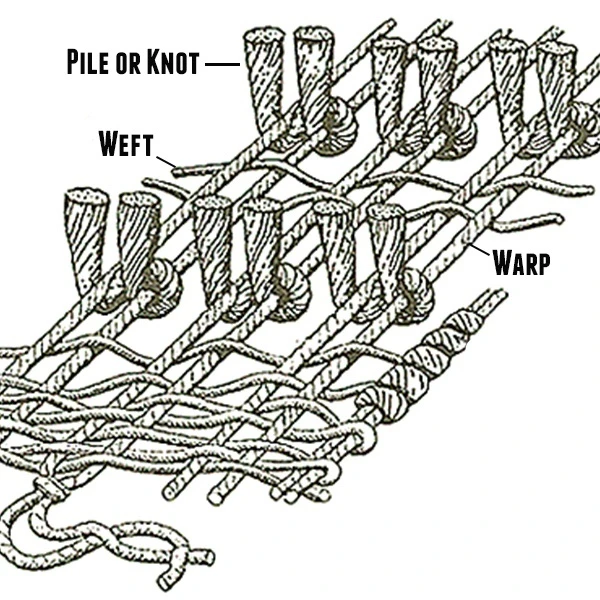
Hand-knotting is an ancient art used to make rugs that are masterpieces of intricate designs. A hand-knotted rug is a one-of-a-kind rug that is woven completely by hand on a special loom. Traditionally, hand-knotted rugs are made with a specially designed loom. Vertical threads are tied onto the loom and eventually become the fringe of the rug. Horizontal threads intertwine to create a foundation. Knots are tied to the vertical threads, and then cut and tied again to secure each knot. Popular types of hand-knotted rugs include Oriental and Persian rugs. These rugs are made from natural materials, such as wool, silk, and cotton. They have a flatter pile with less texture. These are your traditional Persian rugs. A knot is created using the following steps.
That creates one knot and it can now be cut. This is a little complicated but the photo below will help.
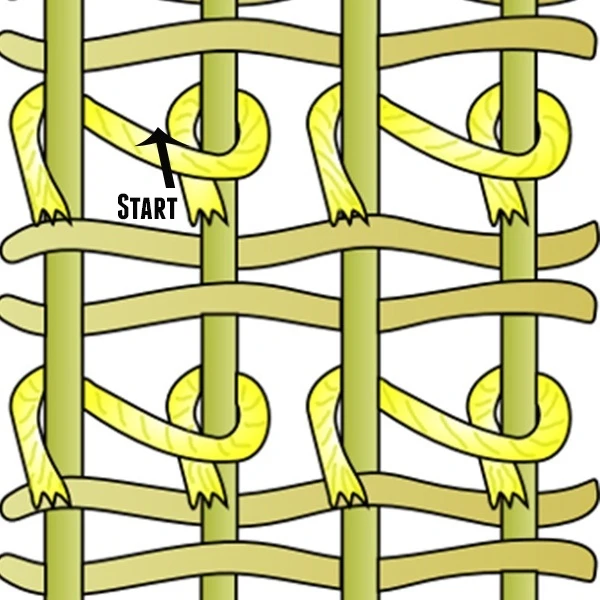
There are three main knots used in hand-knotted rugs.
The symmetrical knot, also known as the Turkish knot or the Ghiordes knot from its origin in North-West of Persia where it was originally used. Sometimes this knot also goes by the name of turkbaff.
In the symmetrical knot the yarn is placed (marked with red in the illustration) in a loop around each and one of the two warps (light yellow). Between every row of knots a weft is placed (colored with blue) in one or many rows.
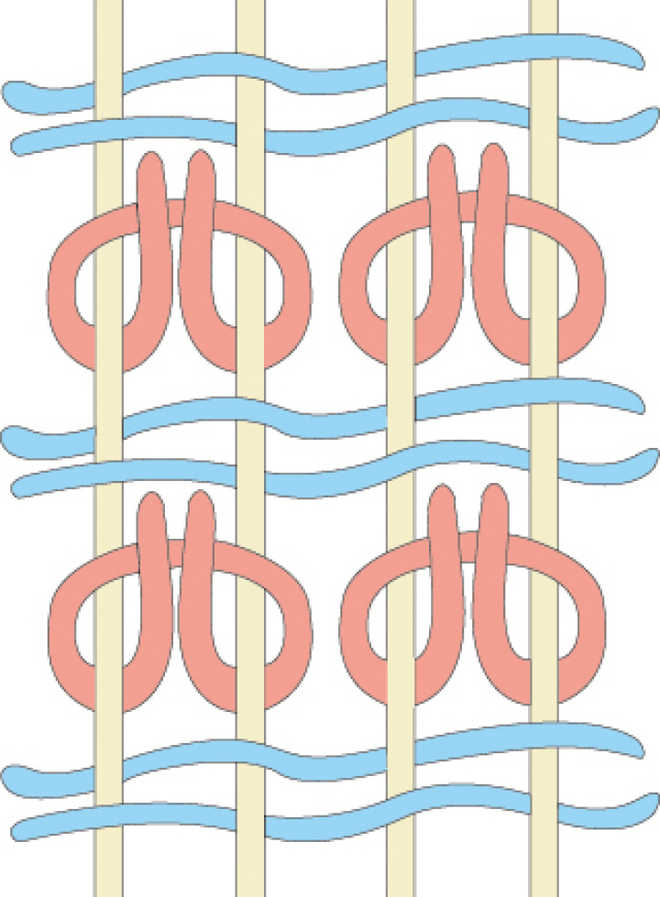
The Turkish knot is symmetrical and leaves two small bumps within each knot on the back of the rug—it ends up looking like a double knot. The symmetrical knot provides a stronger consistency to the carpet and is often used for thicker carpets. Turkey, Caucasian area (Armenia and Azerbaijan), and north western Iran (by Turkish and Kurdish tribes) are more likely to use this type of knot.
The asymmetrical knot is also known as the Persian knot or the Senneh knot. Sometimes it goes by the name farsibaff. The asymmetrical knot makes it possible to weave a carpet with higher knot density and more details.
In the asymmetrical knot the yarn (marked with red) is placed in a loop around one warp thread (light yellow) and remains loose under the other warp thread. Between every row of knots the weft (blue) is placed in one or more rows.
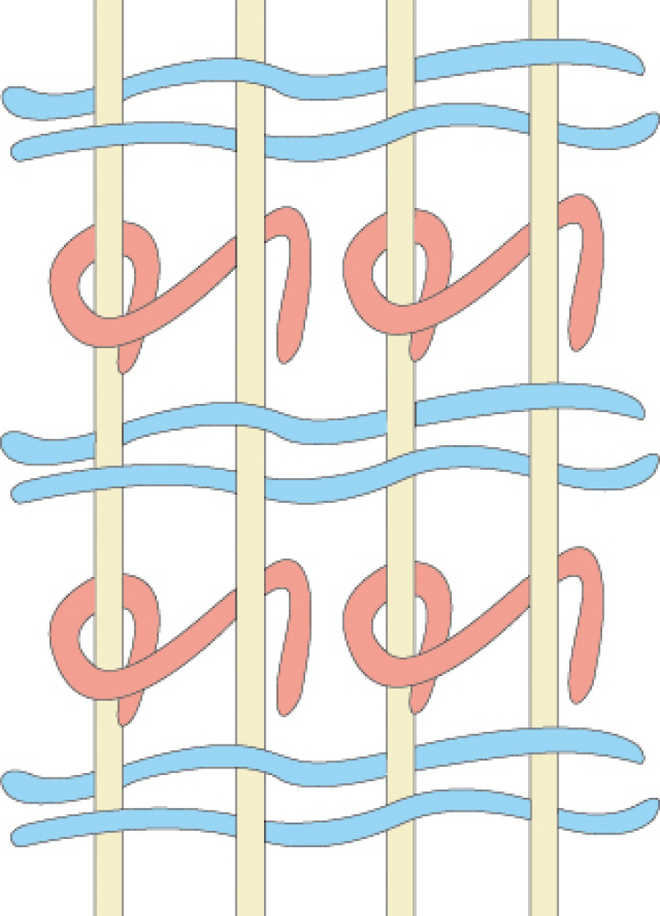
The Persian knot is asymmetrical and open to one side, which leaves fewer gaps and is less bulky than Turkish knots. Persian knots are most commonly used for intricate designs and floral patterns. Iran, Afghanistan, Pakistan, India, Nepal, Tibet, Egypt, Turkey, and China typically use the Persian knot.
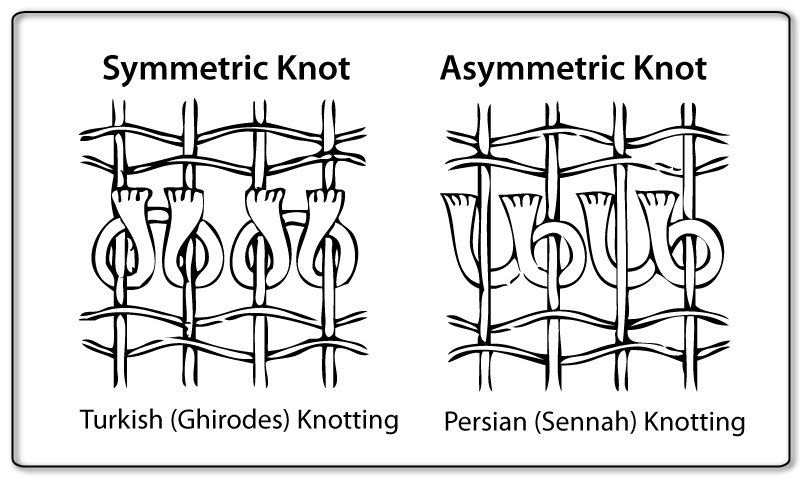
The Jufti knot, or false knot, is tied around four threads instead of two, creating a short cut. The weaver spends less time on a rug when using a Jufti knot, which results in quicker processing time and a lower value and quality.
A Jufti knot means that the knot (marked with red) is placed over four, instead of two, warp threads (light yellow) . The weft (blue) is placed in one or more rows.
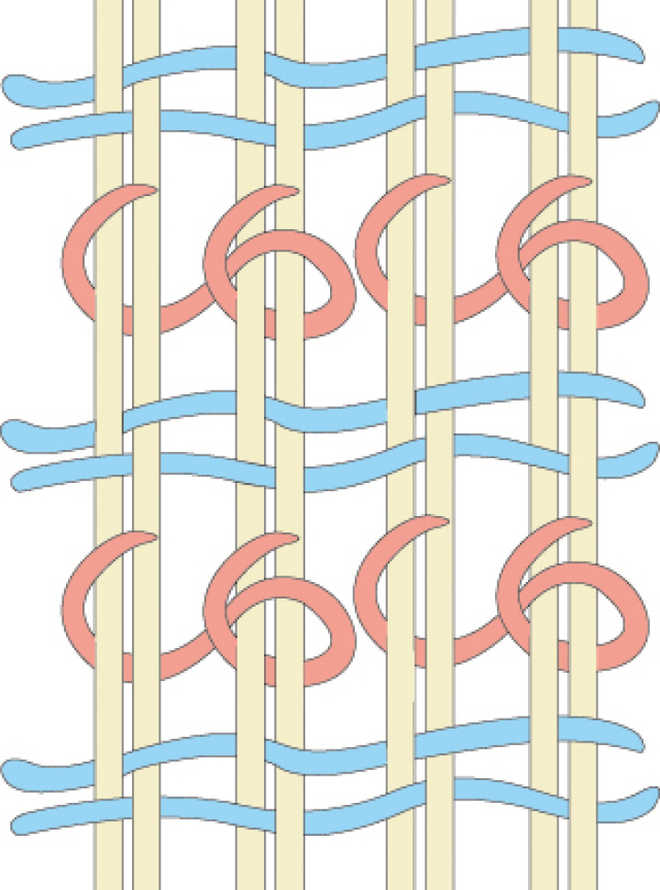
When weaving a carpet with this knot, the work goes on faster, but at the expense of the knot density. The carpets also tend to be less durable and the surface can sometimes look loose and shaggy. Of course the carpet is cheaper but also much worse. The knot can be both symmetrical and asymmetrical.
The Jufti knot can be found in Khorasan carpets.
The Tibetan knot has a completely different structure than the other knots. This knot is made by using a temporary rod (brown in the illustration) along the width of the carpet, which is placed in front of the warp (light yellow). The long yarn (red) is then placed around two warp threads (light yellow) and then around the rod.
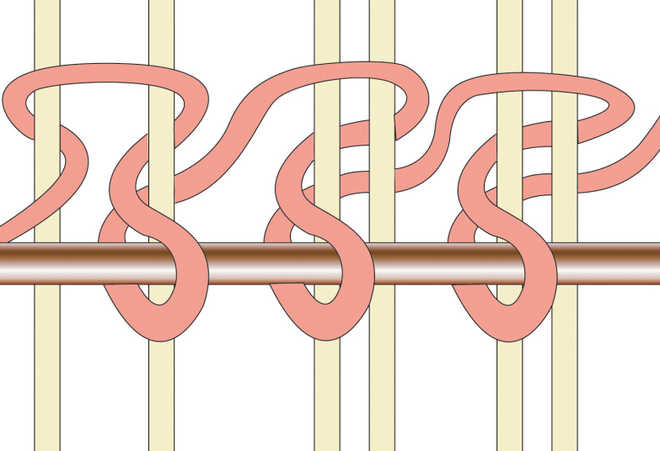
When the weaver is done with the entire row of knots the loops around the rod are cut to create the knot.
The U-knot does not have any knot! This is the weaving technique of machine-made rug where the yarn is placed around warp threads without making a knot. In the right side photo, you can compare machine-made knot, Turkish knot, and Persian Knot.
Weaving a hand-knotted rug requires a great deal of skill and often a lot of time to produce. The quality and very often the cost of a hand-knotted rug is determined by the number of knots per square inch. In this case, a higher density means better quality. However, always remember that although you can count the knots, knots alone doesn’t count! The number of knots on a hand-knotted rug will determine the value, along with age, design, and material.
A complex pattern can require very dense knotting, and thus it can take a long time to produce. It can often take months to complete a hand-knotted rug. An average weaver can tie about 8,000-10,000 knots per day. So you can imagine how long it can take to complete one rug, especially if it happens to be a large one. The time involved in making it also accounts for hand-knotted rugs costing more on average than other type of rugs. Hand-knotted rugs can take anywhere from 30 days to 8 years to complete.
The facts pertaining to the knot count of an Oriental rug are a little complicated. Just counting the knots per square inch (kpsi) alone normally does not give a true indication of the quality of an Oriental rug. One also needs to know the type, and the village or the tribe that the rug comes from. Each country of origin has a traditional knot count specific to that area. For example, a medium knot count of 200 kpsi might be the finest example of weaving from a particular nomadic tribe. In turn, a high knot count of 6000 kpsi for a fine city rug may not necessarily be the finest for that area, as the finest rug from the area may normally be 9000 kpsi. Therefore, purely counting knots without knowing the type and origin of the rug is not a good indication of it’s quality or value.
Since the knots in a rug are tied by hand and since a weaver can tie approximately 8,000-10,000 knots per day, the number of knots per square inch (kpsi) times the number of square inches gives some approximation of the labor content. It can literally take 9-12 months to produce one 9′ x 12′ hand knotted Oriental rug!
Typically, the pattern and colors are what makes a rug attractive to the beholder! And since the joy of an Oriental rug is the pattern, the complexity of the pattern and the execution of the weave, these complexities make it difficult to compare similar knots per square inch from the different countries, villages or nomadic tribes. In addition, each country and tribe has a different method for defining their basis for knot counts. There are also many knot constructions used by each country or tribe as we described earlier in this text. Below is a very brief definition and comparison chart for a few major rugs producing countries.
India developed a quality rating system that we have listed below. Two numbers are used as such; 9/9. The first number is the number of knots in 0.9 of an inch of the rugs width. The second figure is the number of knots in 4.5 inches of the rugs length. This is the conversion chart to knots per square inch (KPSI).
| Row | Quality | KPSI (knots per square inch) |
|---|---|---|
| 1 | 3.5/32 | 28 |
| 2 | 5/28 | 35 |
| 3 | 5/32 | 40 |
| 4 | 6/6 | 36 |
| 5 | 6/40 | 59 |
| 6 | 6/45 | 67 |
| 7 | 7/18 | 31 |
| 8 | 7/40 | 69 |
| 9 | 8/8 | 64 |
| 10 | 8/36 | 71 |
| 11 | 9/9 | 81 |
| 12 | 9/25 | 56 |
| 13 | 9/54 | 120 |
| 14 | 9/60 | 133 |
| 15 | 10/10 | 100 |
| 16 | 10/14 | 35 |
| 17 | 10/32 | 79 |
| 18 | 10.5/48 | 124 |
| 19 | 11/32 | 87 |
| 20 | 12/60 | 178 |
| 21 | 13/65 | 209 |
| 22 | 14/14 | 196 |
| 23 | 16/80 | 316 |
A ruler of 12 inches is used to count the number of pairs of warps in one linear foot. Since the construction is square, you multiply the number of pairs of warps or the “line” count by itself and divide by 144 for the number of knots per square inch. For example 120 line is 120 x120 then divided by 144 or 100 knots per inch.
| Row | Line | KPSI |
|---|---|---|
| 1 | 50 | 17 |
| 2 | 60 | 25 |
| 3 | 70 | 34 |
| 4 | 80 | 44 |
| 5 | 90 | 56 |
| 6 | 100 | 69 |
| 7 | 110 | 84 |
| 8 | 120 | 100 |
| 9 | 130 | 117 |
| 10 | 150 | 156 |
| 11 | 160 | 180 |
| 12 | 200 | 278 |
| 13 | 300 | 625 |
Persian rugs are based on a unit of measure called “raj” or about 7 cm. Most, but not all, of the best rugs have a square knot construction or the same number of knots in both width and length. Below is a basic chart converting raj to knots per square inch.
| Row | Raj | KPSI |
|---|---|---|
| 1 | 30 | 118 |
| 2 | 40 | 210 |
| 3 | 50 | 329 |
| 4 | 60 | 473 |
| 5 | 70 | 675 |
| 6 | 90 | 1066 |
We hope you got an idea how different knot types and knot density work. If you have further questions, feel free to contact us.